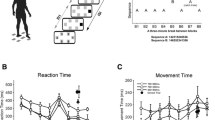Abstract
When exposed to a regular sequence, people learn to exploit its predictable structure. There have been two major ways of thinking about learning under these conditions: either as the acquisition of general statistical information about the transition probabilities displayed by the sequence or as a process of memorizing and using separate chunks that can later become progressively composed with extended practice. Even though chunk learning has been adopted by some theories of skill acquisition as their main building block, the evidence for chunk formation is scarce in some areas, and is especially so in the continuous serial reaction-time (SRT) task, which has become a major research tool in the study of implicit learning. This article presents a reappraisal, replication and extension of an experiment that stands so far as one of the few alleged demonstrations of chunk learning in the SRT task (Koch and Hoffmann, Psychological Res., 63:22–35, 2000). It shows that the effects which were taken as evidence for chunk learning can indeed be obtained before any systematic training and thus surely reflect a preexistent tendency rather than a learned outcome. Further analyses of the effects after extended practice confirm that this tendency remains essentially unchanged over continuous training unlike what could be expected from a chunk-based account of sequence learning.





Similar content being viewed by others
References
Christiansen, M. H., Allen, J., & Seidenberg, M. S. (1998). Learning to segment speech using multiple cues: A connectionist model. Language and Cognitive Processes, 13, 221–268.
Cleeremans, A. (1993). Mechanisms of implicit learning: A connectionist model of sequence processing. Cambridge: MIT Press.
Frensch, P. A., Buchner, A., & Lin, J. (1994). Implicit learning of unique and ambiguous serial transitions in the presence and absence of distractor task. Journal of Experimental Psychology: Learning, Memory, and Cognition, 20, 567–584.
Inquisit 1.33 [Computer software]. (2003). Seattle, WA: Millisecond Software L.L.C.
Jiménez, L., Vaquero, J. M. M., & Lupiáñez, J. (2006). Qualitative differences between implicit and explicit sequence learning. Journal of experimental psychology: Learning, Memory, and Cognition, 32, 475–490.
Koch, I., & Hoffmann, J. (2000). Patterns, chunks, and hierarchies in serial reaction-time tasks. Psychological Research, 63, 22–35.
Koch, I., Philipp, A. M., & Gade, M. (2006). Chunking in task sequences modulates task inhibition. Psychological Science, 17, 346–350.
Nissen, M. J., & Bullemer, P. (1987). Attentional requirementes of learning: Evidence from performance measures. Cognitive Psychology, 19, 1–32.
Perruchet, P. (2005). Statistical approaches to language acquisition and the self-organizing consciousness: A reversal of perspective. Psychological Research, 69, 316–329.
Perruchet, P., & Gallego, J. (1997). A subjective unit formation account of implicit learning. In D. Berry (Ed.), How implicit is implicit learning (pp. 124–161). Oxford, UK: Oxford University Press.
Perruchet, P., & Vinter, A. (1998). PARSER: A model for word segmentation. Journal of Memory and Language, 39, 246–263.
Perruchet, P., & Vinter, A. (2002). The self-organizing consciousness. Behavioral and Brain Sciences, 25, 297–388.
Perruchet, P., & Pacton, S. (2006). Implicit learning and statistical learning: One phenomenon, two approaches. Trends in Cognitive Sciences, 10, 233–238.
Reed, J., & Johnson, P. (1994). Assessing implicit learning with indirect tests: Determining what is learned about sequence structure. Journal of Experimental Psychology: Learning, Memory, and Cognition, 20, 585–594.
Sakai, K., Kitaguchi, K., & Hikosaka, O. (2003). Chunking during human visuomotor sequence learning. Experimental Brain Research, 152, 229–242.
Schneider, D. W. (2007). Task-set inhibition in chunked task sequences. Psychonomic Bulletin and Review (in press).
Servan-Schreiber, E., & Anderson, J. R. (1990). Learning artificial grammars with competitive chunking. Journal of Experimental Psychology: Learning, Memory, and Cognition, 16, 592–608.
Stadler, M. A. (1993). Implicit learning: Questions inspired by Hebb (1961). Memory and Cognition 21, 819–827.
Stadler, M. A. (1995). Role of attention in implicit learning. Journal of Experimental Psychology: Learning, Memory, and Cognition, 21, 674–685.
Vaquero, J. M. M., Jiménez, L., & Lupiáñez, J. (2006). The problem of reversals in assessing sequence learning with serial reaction time tasks. Experimental Brain Research, 175, 97–109.
Verwey, W., & Eikelboom, T. (2003). Evidence for lasting sequence segmentation in the discrete sequence-production task. Journal of Motor Behavior, 35, 171–181.
Verwey, W., Lammens, R., & Van Honk, J. (2002). On the role of the SMA in the discrete sequence production task: A TMS study. Neuropsychologia, 40, 1268–1276.
Acknowledgements
This research has been supported by the Spanish Ministerio de Educación y Ciencia with grants BSO2003-05095, SEJ2005 25754-E and SEJ2006 27564-E. The author wishes to thank Gustavo Vázquez for his assistance in data collection, and Peter Frensch, Iring Koch, Pierre Perruchet and an anonymous reviewer for their thoughtful suggestions on an earlier version of the manuscript.
Author information
Authors and Affiliations
Corresponding author
Rights and permissions
About this article
Cite this article
Jiménez, L. Taking patterns for chunks: is there any evidence of chunk learning in continuous serial reaction-time tasks?. Psychological Research 72, 387–396 (2008). https://doi.org/10.1007/s00426-007-0121-7
Received:
Accepted:
Published:
Issue Date:
DOI: https://doi.org/10.1007/s00426-007-0121-7




